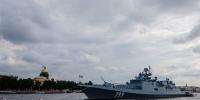Okr world theme. Lesson on the surrounding world on the topic "what is the surrounding world"
The world around us is one of the most interesting and fascinating lessons in primary school. This is the world around us, these are animals and plants, this is space, the entire universe is in the palm of our hands. The child begins to understand the peculiarities of its functioning and learns how everything happens in this world. The world around us in primary school, grades 1, 2, 3, 4, is a preparation for a child’s understanding of such subjects as biology, physics, chemistry, astronomy, and physics. This is a necessary knowledge base. To accumulate a good foundation, you need to read a lot, and parents need to work with their child. They will help you in your studies methodological manuals, which you can download and print for free from our website.
Abstract to the material
Presentations on the world around us will allow the primary school teacher to make this subject a favorite among the majority of primary school students. With a competent selection of visuals and an accessible explanation of new material, students awaken interest in studying each subsequent topic and a desire to learn more than was given in the lesson. After watching a presentation on the topic of the world around us, little discoverers of secrets will try to find on their own interesting information about plants and animals, about stars and natural phenomena, in order to tell these facts to your teacher and classmates in class.
The presentation on the lesson about the world around us is easy to use at any stage of the lesson. Its use is not limited solely to explaining new material. Can download a presentation on the world around us for grades 1, 2, 3 or 4 for practical work and for checking homework, for consolidating the material just learned in class and for showing samples of project design.
Using a presentation on the lesson about the world around us helps students become motivated to learn. They are pleased that they understand the material that the teacher explains. If not everyone can solve a problem in mathematics, and writing in a Russian language lesson without mistakes is also not easy, then in a lesson about the world around you, you can reveal your abilities and become a real star. It is not without reason that Ushinsky noted that children’s nature requires clarity in order to develop interest in a subject. These words are still relevant and true today. Using presentation by environment the world is irrefutable proof of this. It is not so much the text that is important in them, but pictures, photos, inserted video fragments, tables, various schemes that will remain in the memory of an elementary school student.
This section contains lesson developments from teachers working in various educational systems. From the sections you can download free lessons with a presentation on the world around you for grades 1, 2, 3, 4 according to the teaching materials of School 2100, School of Russia, PNS (textbooks by Pleshakov, Vakhrushev) and use them in your work.
Do you like to create presentations for lessons about the world around you and do you already have a collection of your own designs? Send them to us, and we will definitely, preserving the authorship, place them in the appropriate section. To create your own works and children's projects, on our portal you can download free presentation templates, backgrounds and pictures of the world around you. Let's collaborate and share best practices that shouldn't become unnecessary after the bell rings from class.
The world around us - 1st grade
Presentations at the lesson of the surrounding world in 1st grade are becoming an urgent need. A child who is so different from his peers studying at school even just ten years ago does not accept old approaches to working in the classroom. His interest can only be supported modern means training - bright, dynamic, intriguing. It is to them that...
The world around us - 2nd grade
Presentation on the surrounding world for 2nd grade - this is the best material for modern lesson in primary school. Kids love to listen, but it is unlikely that they will be able to explain the essence of a complex problem with words alone. And then she comes to the rescue, the almighty presentation of a lesson on the world around us in grade 2 - a unique multimedia product...
The world around us - 3rd grade
A presentation on the environment in 3rd grade allows a creative teacher to turn an ordinary, ordinary lesson into a kind of holiday for children, from which they will not want to leave even after the bell rings. They have a desire to endlessly travel through forests and fields, discover previously unknown minerals, get acquainted with the economy and comprehend laws...
The world around us - 4th grade
Presentations “The world around us, grade 4” introduce the modern child, who lives in close proximity to a computer, to the world of electronic culture. It becomes easier for the teacher to explain the topics of the lessons, since he does it in a language understandable to the generation of today's students. Using electronic developments, it is possible to form the basic competencies of students, increase their motivation to learn in...
Presentation The work of Yuri Vladimirov The presentation first introduces the second grade children to the work and biography of Vladimirov, who is the author of the poem “Weirdos”. This children's poet. like his work, it is not known...Presentation Chukovsky Fedorino grief The presentation will be used in 2nd grade when getting acquainted with the work of Korney Chukovsky. At the same reading lesson, students will become acquainted with his fairy tale “Fedorino's Grief”...Presentation Nikolai Nosov The Living Hat Presentation for a lesson in 2nd grade according to the Federal State Educational Standard based on the story of Nikolai Nosov “The Living Hat” contains material about the author’s work, about his life, about works written...The subject “The world around us” in primary school lays the foundation for the development of children’s cognitive interest in such natural and social sciences as geography and biology, physics and chemistry, history and social studies. This subject became a rethinking and addition to the previous school natural history course. It is designed to accustom children to a holistic, rational comprehension of the very surrounding world in which we live.
This thematic section contains ready-made lesson notes, project activities, integrated classes, extracurricular activities about the world around us in elementary school. The range of topics presented is very wide. It covers everything curriculum course and is not limited to it.
Examples of conducting lessons on the world around us - to help teachers.
Contained in sections:Includes sections:
Showing publications 1-10 of 320.
All sections | The world
Techniques of critical thinking in the lessons of the Russian language and the surrounding world Technique for writing syncwines. Changes taking place in modern education, put forward as a priority the problem of using new technologies of training and education. In Russian language lessons, literary reading, the surrounding world, at the stage of assimilation of new knowledge you can...
Development of a lesson on the surrounding world in 4th grade “Life of the ancient Slavs during the times of Ancient Rus'” Subject. Life of the ancient Slavs. During times Ancient Rus'. Target: educational: to form in students an idea of Ancient Rus', Russian princes, the life of the ancient Slavs, their religion; developing: develop oral speech students, imagination, imagination, ability to work with...
The world around us - “Journey to the land of road signs.” Summary of a lesson on the surrounding world using gaming technology in grades 2 and 4
Publication “Journey to the Land of Road Signs.” Lesson summary of the environment...” Municipal educational institution "Staropolskaya Secondary School" The world around us: a lesson using game technology in grades 2, 4 Prepared and conducted by: primary school teacher Khozyainova E. V. Objectives: 1. To expand students’ knowledge about the rules of behavior on the road. 2. Foster a sense of caring attitude towards your...
Image library "MAAM-pictures"
Lesson summary on the surrounding world in 3rd grade “Golden Ring of Russia” Lesson summary on the topic “Golden Ring of Russia” Goal: to form the foundations of civic identity, a sense of pride in one’s Motherland. Objectives: 1. Expand children's knowledge about the cities of the Golden Ring. 2. Learn to recognize a city by its main attractions and reproduce in...
Test on the world around us “Wise choice”, 4th grade, world around us, UMK A. A. Pleshakova, M. Yu. Novitskaya (“Perspective”) Test “Wise Choice” 1. In what year did the baptism of Rus' take place? a) in 862 b) in 1157 c) in 988 2. The Grand Duke of Kiev, who baptized Rus'. a) Prince Vladimir b) Prince Yuri Dolgoruky c) Prince Yaroslav the Wise 3. Day...
Test work on the surrounding world “The Beginning of the Moscow Kingdom”, 4th grade UMK A. A. Pleshakova, M. Yu. Novitskaya Verification work“The Beginning of the Moscow Kingdom” Surname _ 1. How was the grand-ducal throne passed on? _ 2. Why did the Russian people flee to uninhabited areas - to the steppe, to the Don river islands, to the Volga Zhiguli mountains? _ _ 3. What were the freestyles called...
The world around us - Lesson notes on the world around us for 1st grade “Do-it-yourself healthy products”
Subject: " Healthy foods with your own hands” Goal: - to promote in children the ability to conduct cognitive and research activities. Objectives: 1. Using research activities, find out what benefits milk brings children's body. 2. Promote...
Theoretical foundations for the formation of research competencies in lessons on the subject “The World around us” The problem of educational research activities has deep roots. Foreign teachers (J. J. Rousseau, I. Pestalozzi, F. Diesterweg, G. Kerschensteiner, J. Dewey, S. Frenet) expressed the idea of encouraging a child to understand the world through research and discovery. In Russia this position...
Plan
1. Arctic deserts
2. Tundra
3. Forest zone
a) taiga
b) mixed forests
c) deciduous forests
4. Steppes
5. Desert
6. Subtropics
Arctic deserts
Arctic - this is the zone of islands lying around North Pole. It's long here Cold winter The summer is short, cold, and therefore the vegetation is sparse - mosses and lichens.
In the Arctic, the sun does not set for several months - the polar day continues. For several months it is light around the clock, but not warm. The temperature is only a few degrees above 0. In winter, the polar night sets in. The dark ones are dark and very cold. The darkness is illuminated by the moon, stars and Northern Lights.
This is a very cold zone. But this does not mean that there are no animals and plants on it.
Arctic - the kingdom of the polar bear. The lack of land does not bother him; his main habitat is the ice floes of the Arctic Ocean. Polar bear feeds on fish, hunts seals, seals, and walrus cubs.
Numerous pinnipeds also live in the Arctic - seals, seals, walruses, elephant seals. Their elongated, streamlined body shape helps them move through the water at tremendous speed.
Numerous birds find shelter and nest on the coastal cliffs in the summer, setting up “bird markets” on the rocks - geese, gulls, eiders, terns, waders. In rock cracks where small amounts of soil accumulate, in thawed areas of glacial deposits - moraines, mosses, lichens, some types of algae and even cereals and flowering plants settle near snowfields. Among them are bluegrass, cotton grass, polar poppy, sedge, dwarf willows, birch trees. During the cold polar summer they manage to bloom and even bear fruit.
Unfortunately, due to human exploration of the Arctic, complex problems have arisen here. ecological problems: pollution of the northern seas; destruction of commercial fish species; hunting for polar bears and seals. Currently, hunting rare animals in the Arctic is prohibited. Some bird colonies have been placed under protection. Fishing is limited. Nature reserves have been created, for example, the WRANGEL ISLAND nature reserve.
Tundra
The climate of the tundra is harsh - winter lasts longer than the school year. All year round Fierce winds blow, and blizzards rage in winter. Even in summer, the ground practically does not thaw (only 10–25 cm), and permafrost remains below.Birches spread near the surface, hiding from the wind and cold in mosses and lichens.
Ptarmigan, snowy owl, gyrfalcon, reindeer, and wolves live permanently in the tundra; geese and cranes arrive in the summer.
The main occupation of the tundra population is reindeer herding. There is also mining of minerals - oil and gas.
Environmental problems have arisen in the tundra:
soil disturbance from the tracks of tractors and all-terrain vehicles - plants die.
The area is contaminated with oil during its extraction.
illegal hunting - poaching.
reindeer pastures are trampled down because the reindeer are not always moved to other places.
Forest zone
Taiga – coniferous forest, it occupies most of the zone.
Mixed forest – along with coniferous trees, birch, aspen, and alder grow in it. Winter in such a forest is milder. U deciduous trees medium-sized leaves that they shed for the winter.
broadleaf forest - replaced by oak, linden, maple, ash, elm. These are heat-loving plants, so they have large leaves, shed their leaves in the winter, and reproduce by seeds.
Due to human fault arise ecological problems . If used to be a forest They cut down as needed, but now they cut down everything they can. Excessive hunting has led to the complete or almost complete extinction of some animal species.
Steppes
The steppes stretch in a narrow continuous strip in the south of Russia from the western borders to Altai. Further to the east, steppe areas have a focal distribution.average temperature January in the heat of -2 °C, and in the east -20 °C and below. Summer in the steppe is sunny and hot. The average temperature in July is 22-23 °C. In the west of the zone there are often thaws, so the snow cover there is thin and very unstable. The predominant soils of the steppes are chernozems.
Natural plant communities are predominantly represented by perennial, drought- and frost-resistant grasses with a strong root system. These are primarily cereals: feather grass, fescue, wheatgrass, snake grass, tonkonogo, bluegrass. In addition to cereals, there are numerous representatives of forbs: astragalus, sage, cloves - and bulbous perennials, such as tulips.
In the European steppes, the basis is made up of narrow-leaved grasses: feather grass, fescue, bluegrass, fescue, tonkonogo, etc.
In the drier southern regions, in addition to cereals, wormwood, milkweed, and cinquefoil are common. There are many tulips in spring. Tansy and cereals predominate in the Asian part of the country.
Ungulates are adapted to long movements across the vast expanses of the steppes. Due to the thinness of the snow cover, plant food is also available in winter. Bulbs, tubers, and rhizomes play an important role in nutrition. For many animals, plants are also the main source of moisture. Typical representatives of ungulates in the steppes are aurochs, antelopes, and tarpans. However, most of these species result economic activity people were exterminated or pushed south. In some areas, saigas, which were widespread in the past, have been preserved.
The most common rodents are the ground squirrel, the vole, the jerboa, etc. The ferret, badger, weasel, and fox also live in the steppe.
Among the birds typical of the steppes are the bustard, little bustard, gray partridge, steppe eagle, buzzard, and kestrel. However, these birds are now rare.
There are significantly more reptiles than in the forest zone. Among them we will highlight the steppe viper, snake, common grass snake, quick lizard, and copperhead.
The wealth of the steppes - fertile soils . This natural area almost completely developed by humans and natural steppe landscapes are preserved only in nature reserves. Due to insufficient precipitation and frequent droughts, irrigation systems were built in the steppe zone.
Steppes - zone of developed livestock farming. Big ones are bred here cattle, horses, poultry. Various industries are developed: metallurgy, mechanical engineering, food, chemical, textile.
Desert
In Russia, the desert occupies a small area - along the shores of the Red Sea. Huge deserts lie in other countries: Kazakhstan, Turkmenistan, Uzbekistan. It's very hot in the desert.Typical soils in the semi-desert and desert zones are chestnut.
Most animals in the desert are small because they have nowhere to hide from predators. The most common reptiles are lizards, snakes, and turtles.
Birds - bustard, little bustard, larks.
Of the most large mammals Let's note the camel, saiga; there are corsac dogs and wolves.
Camel
– he has many adaptations to live in the desert. Long thick eyelashes protect your eyes from sand. Both toes on each foot are connected by a calloused pad. Thanks to her, he doesn't fall into the sand.
The traditional occupation of the population is cattle breeding: They raise sheep, camels, and cattle. As a result of overgrazing, the area of unconsolidated dispersed sand increases. One of the measures to combat the onset of the desert is phytomelioration - a set of measures for cultivating and maintaining natural vegetation.
People built canals to irrigate the land. This is good. But excessive irrigation led to a lot of salt in the soils. Poaching is also a problem.
The culprit of the problems created is man. Now people are faced with the difficult task of correcting their mistakes.
Subtropics
This zone occupies Black Sea coast The Caucasus is characterized by the smallest extent and area in Russia.Fertile red earth and yellow earth soils are widespread.
Subtropical vegetation rich and varied. Vegetable world represented by evergreen hard-leaved trees and shrubs, among which we name boxwood, laurel, and cherry laurel. Forests of oak, beech, hornbeam, and maple are common. The thickets of trees are intertwined with liana, ivy, and wild grapes. There are bamboo, palm trees, cypress, eucalyptus.
Among the representatives of the animal world, we note chamois, deer, wild boar, bear, pine and stone marten, and Caucasian black grouse.
The abundance of heat and moisture makes it possible to grow subtropical crops such as tea, tangerines, and lemons here. Significant areas are occupied by vineyards and tobacco plantations.
Favorable climatic conditions, proximity to the sea and mountains make this area large recreational area our country. There are numerous tourist centers, holiday homes, and sanatoriums here.
Views: 57,467
You might be interested

What is the world around us? It would seem a simple question that even a child in first grade can answer. However, if you dig a little deeper, it turns out that in reality everything is much more complicated. And the older and more educated a person is, the more complex his version of the answer is.
The reason for this is the great intellectual leap that humanity has made on the path of its evolution. Many religious movements philosophical schools And scientific theories gave us the opportunity to change the interpretation of the answer to this question at our own discretion. Therefore, let's try to find out for ourselves what the world around us really is.
The truth is in simplicity
First, let's look at this question based on logic. common man, without delving into the subtle matters of the universe. So, the surrounding world is the space that surrounds us. And it is precisely at this moment that the first controversial statements appear.
If you look at it, it is quite difficult to outline the boundaries separating one space from another. After all, there are no specific standards that can organize all this knowledge in the heads of billions of people. In this regard, if you ask the usual question about what the world around us is, we will get different answers.
For example, for some it may be the space that directly surrounds them. For others, everything is much more complicated, and by this concept they mean our entire planet or even the Universe.
The world around us: wildlife
However, despite all the variety of answers, there are those that can be separated into a separate group. This is because, despite the minor differences, they still share some similarities that lead to a common idea.

In particular, many believe that the world around us is all living things around us. The same forests, fields, rivers and deserts. Animals and plants are also included here, as they are an integral part of this world.
What is the world around us through the eyes of philosophers?
Philosophers and theologians consider this issue more deeply. After all, for them our world is part of a more complex reality. For clarity, let us consider the main features of their views on the current order of things.
According to religion, our reality is a place where people live only part of the path prepared for them. That is, the world around us is just a screen, hiding from view a more beautiful place - paradise.
As for philosophers, they formulate the answer to this question more vaguely. Depending on the school, a thinker may define the concept of the surrounding world differently. For some it is a material place, for others it is a spiritual place, and for others it is a combination of the two previous ones.




